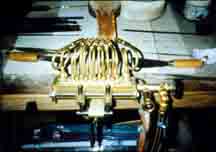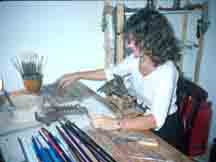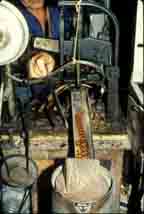 |
Principal path =Home>Beadmaking & MaterialsorCzech Beadmaking>Video
Bohemia Beadmaking: the Video
From the late 1970s to the mid 1980s Shari Hopper visited glass beadmakers in Central Europe to learn their techniques and document how they made beads. Her inquiring mind took her to Lauschau, then in East Germany; Kaufbeuren, then in West Germany; and Jablonec, then in Czechoslovakia.
She filmed what she saw and has now edited and presented it in this quite professional video. It is a tour de force, as she not only recorded techniques, but also managed to capture the "spirit" of what was going on. Background sounds and tightly edited pictures make you feel you are there with her taking it all in.
Some of what she has documented has already passed away. Other things point to the future. Hopper has learned and points out many techniques that contemporary art glass beadmakers, such as those in the US, may well emulate.
The video covers a wide range of topics, all related to glassworking. They include the drawing of canes, making buttons and glass eyes, molded and lamp-wound beads and the ergonomics of torch working.
This is a historically important video. It will appeal to beadmakers, collectors, historians and, indeed, to anyone interested in beads. It is suitable for Bead Societies, school libraries, presentations to non-bead groups and for multiple private viewing.
|
|
A beadmaker trained at the Glass and Jewelry Technical School in Kaufbeuren, Germany. She is working in home studio in Landsberg Germany in 1988.
Kaufbeuren and its suburb Neu Gablonz were where most ethic German beadmakers settled after being driven out of Czechoslovakia after World War II.
|
|
A torch similar to that in the picture above, but with the protective hood removed. Multiple curved nozzles converge to make a single very hot flame. Note how it is attached to the table.
This was probably used in Bohemia early in the century. It was introduced to India in the early 1940s and is documented for German refugees just after World War II.
|

|
|
|
The working end of a torch (upper right) being used to heat a cane of glass (center right) that is being pinched off with a tong mold (center left).
Note the protective hood over the torch and the glass shield in front of the worker.
|
|
A display showing glass tubing and the colorants used to make glass.
The Kaufbeuren-Neugablonz Museum, in the House of Industry building.
|

|
|
|
The back of an electric motorized machine hand operated in a garage workshop in Germany in 1989.
The beads are sliding down a chute after having been molded in strips in an operation that pumps half the mold down onto a hot cane of glass (see here).
Hopper says that at the time such machines in Czechoslovakia were manually driven, but I saw electrified ones in operation in 1995.
|
|
Don't just take my word for it.
Read what others are saying about Bohemian Beadmaking.
|
Helen R Hosmer
Glass Line Magazine
I've watched this tape three times within the last twenty-four hours and continue to be enthralled.
This video is put together much like a PBS documentary and is well done. The historical period of time between 1988 and 1993 gives a unique economic view into Czechoslovakia, East and West Germany just before and just after the Berlin Wall came down. It also leaves one wondering why these tiny little bits of glass have held man's fascination to such an extent as to demand such labor intensive, low pay, high sweat, massive muscle and multiple generations of employment.
The final production is very well done. Ms Hopper's scripting and titling through out the 48 minutes is very informative of the process you are watching as well as historical notes for the region. I found the addition of factory sounds and native language in the background to draw me into these intimate scenes of flameworkers in their cottage industry. These are scenes few have ever been privileged to see and most likely will soon be extinct.
|
Elise Mann, Editor, Bead Society of Great Britain Newsletter
The actual shots of the glass and beadmaking work are well done, showing all the kinds of thing you would want to look at if you had the chance to visit the places in question - which is probably because Shari has the same kind of interest in them that most beadmakers would have.
The part I enjoyed most was the small workshops making pressed glass beads with various machinery, because I have not seen this done before other than with single-bead hand presses and I had imagined fully-automated machines (which may exist somewhere, but not in these areas).
When we see a factory with 40 workers making wound glass beads, Shari notes the way the work area is arranged and the posture of the workers. She makes a convincing case for re-organising the way we work beads in the flame - or at least how it is done in the USA (as far as I have seen, British bead workers echo the US setup).
|
|
__________________________________________________
Small Bead Businesses | Beading & Beadwork | Ancient Beads | Trade Beads
Beadmaking & Materials | Bead Uses | Researching Beads | Beads and People
Center for Bead Research | Book Store | Free Store | Bead Bazaar
Shopping Mall | The Bead Auction | Galleries | People | Events
The Bead Site Home | Chat Line | Contact Us | Site Search Engine | FAQ
|
 |




